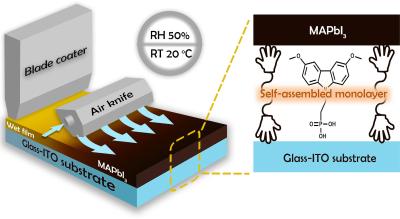Researchers from the City University of Hong Kong and the Southern University of Science and Technology in Shenzhen, China, have shown that a self-assembled monolayer can facilitate the formation of a large-area perovskite film using a blade-coating process, thus promote the upscaling of perovskite photovoltaic technology.
Researchers build perovskite solar cells with layers of material deposited on an underlying substrate. In adapting the high-speed blade-coating method for perovskite thin-film deposition, the researchers realized that the surface properties of the substrate are critical for large-area coating and perovskite growth. The current process leaves voids at the buried interface of the perovskite film that is detrimental to the device performance. “To solve this problem, we have screened various hole-transporting materials and found that self-assembled monolayers are a class of promising materials for the upscaling of perovskite devices,” said Alex Jen, a professor at City University of Hong Kong.
Self-assembled monolayers are an ordered array of organic molecules. They contain an anchoring group that can bond to the substrate and a functional headgroup to passivate the defects for the perovskite on top. These self-assembled monolayer molecules function as linkers, to bond the substrate and perovskite films tightly to eliminate interfacial voids. “Furthermore, since the self-assembled monolayer is a monolayer, charge carriers can be extracted from perovskite to substrate electrode efficiently through charge tunneling, resulting in enhanced device performance,” said Jen.
These functional self-assembled monolayers, that can be solution-processed, are very economical because of the minimal materials required. The self-assembled monolayers prove to be very effective for tuning the perovskite growth and passivating any potential defects. “This novel class of materials is very promising for facilitating the upscaling of perovskite photovoltaic technology,” said Jen.
In future studies, the researchers plan to employ different self-assembled monolayer molecules designed for upscaling the perovskite photovoltaic technology. In addition to further exploration of the self-assembled monolayer molecule design and synthesis, the team also plans to conduct composition engineering of perovskite precursors for upscaling coating methods. The interaction between perovskite and self-assembled monolayers is critical.
In order to achieve highly efficient and stable photovoltaic modules, the coating of perovskites has to be uniform and free of defects. “We believe our research will help reduce the lab-to-fab gap to facilitate the commercialization of perovskite photovoltaic technology,” said Jen.




